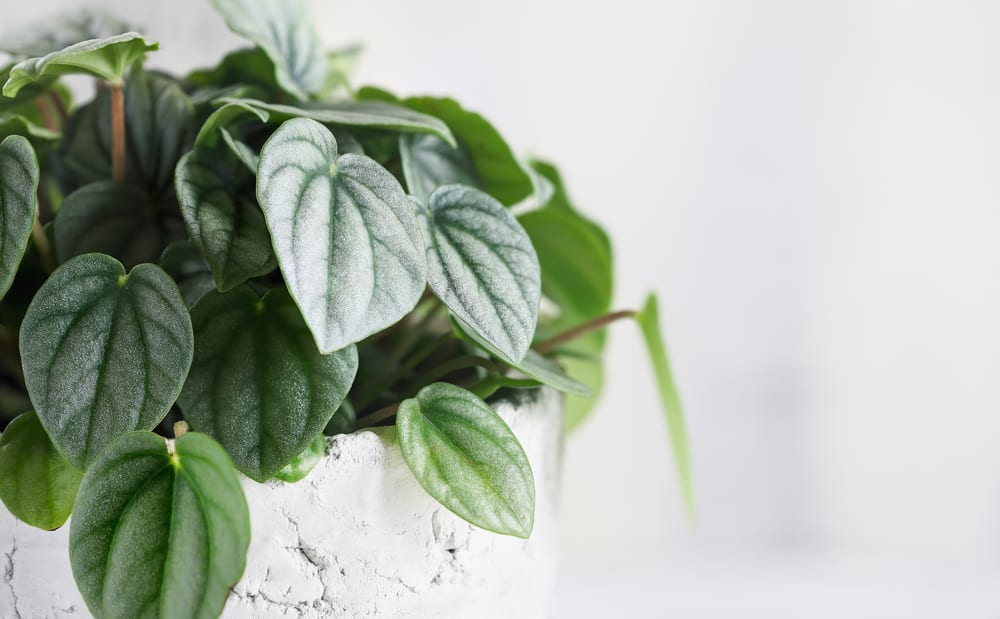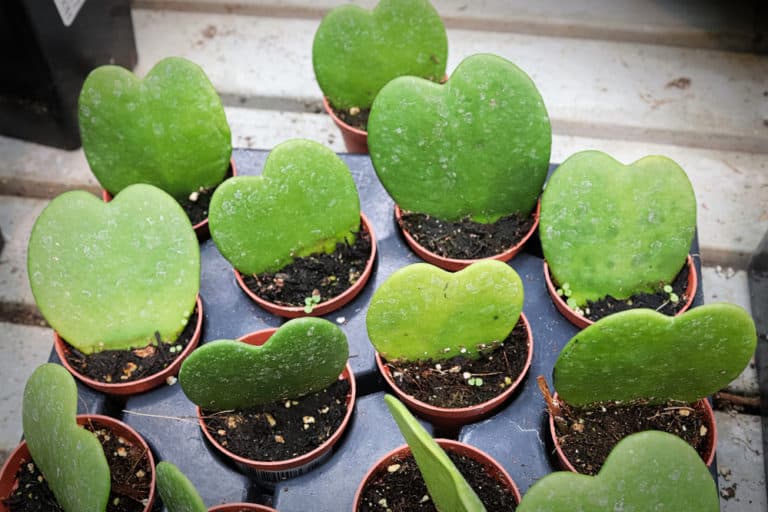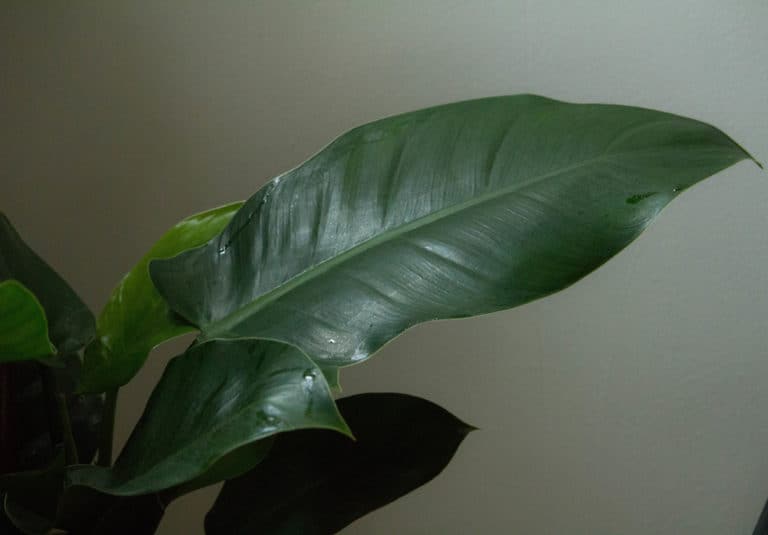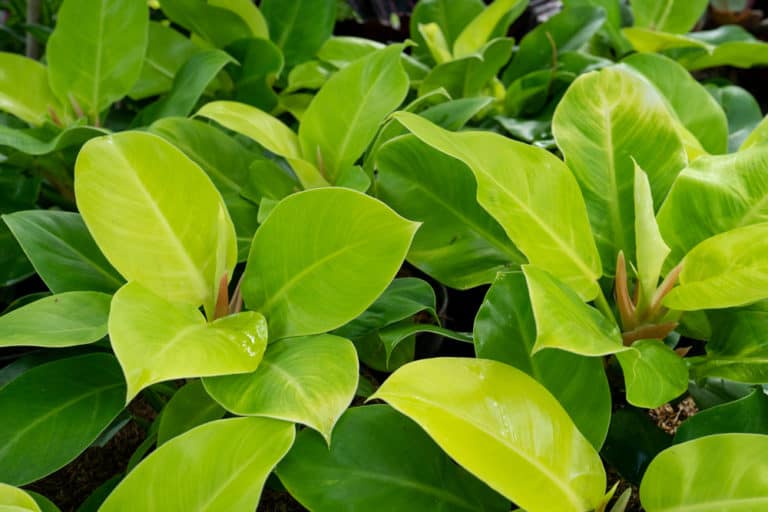Peperomia Caperata ‘Frost’ Care Guide (2024)

Peperomia Frost is a charming little tropical plant that packs a lot of beauty into a small package.
The silvery-green leaves make Peperomia caperata Frost the perfect name for this attractive foliage plant.
Usually grown as a potted houseplant, it is extremely low maintenance for even a beginning indoor gardener.
| Scientific Name | Peperomia caperata ‘Frost’ |
| Common Name | Peperomia Frost, Peperomia Silver Frost |
| Light | Bright indirect sunlight |
| Watering | Water when the top half of the soil is dry |
| Temperature | 60 to 80° F (16 – 27 °C) |
| Hardiness Zone | 10-12 |
| Humidity | 50% |
| Soil Type | Quick-draining |
| Soil pH | 6-6.6 (mildly acidic) |
| Fertilizing | A balanced feed once a month in spring and summer |
| Repotting | Every 2 years |
| Pruning | To remove dead leaves only |
| Propagation | Stem cuttings or root division |
| Toxicity | Not toxic to humans and pets |
| Mature Size | 6 to 12 inches as a houseplant |
| Bloom Time | Summer and autumn |
What’s Unique About Peperomia Frost?
Native to the tropical rainforests of Brazil, Peperomia Frost plants have made themselves right at home as a houseplant.
The peperomia frost scientific name is Peperomia caperata ‘Frost’. It is sometimes called Peperomia Silver Frost because of the unique silver overlay on its green leaves.
Growing Peperomia Frost is easy for even an inexperienced gardener. It needs very little maintenance to grow into a lush clump of leaves.
At the same time, it stays small, growing no more than a foot tall at maturity. This compact size gives you a wide range of options when it comes to finding a spot to showcase it.
Peperomia Frost Care
Since Peperomia Frost originates in the rainforests of Brazil, good Peperomia Frost plant care involves providing it with similar growing conditions.
Peperomia caperata Frost care consists of finding a spot with bright but indirect light, planting it in porous soil, and not watering it too much.
Those simple rules should keep your Peperomia Frost happy and healthy for years.
Light
In the Brazilian rainforest, Peperomia Frost grows in the shade of the tree canopy, so it is used to bright, filtered light in the 10,000-20,000 lux range.
You can easily meet those Peperomia Frost light requirements in your home by finding it a spot out of the full sun.
Frosted Peperomia light needs can be accommodated in a north or east-facing window where the light never gets too intense.
If all your windows face south or west, put the pot in a shadier corner of the room where the direct rays won’t hit it.
As the sun’s angles change with the seasons, you may need to shift your Peperomia Frost from one location to another throughout the year.
Watering
Peperomia Frost may be a rainforest native, but it is used to growing in dry conditions- sometimes just a crack in a rock. In your home its watering needs are the same.
Only water peperomia frost plant when at least the top half of the soil is dried out. Keeping the soil too damp can lead to the development of fungal diseases.
The most effective Peperomia Frost watering is to set the whole pot into the sink or a pail of water, and let the soil become evenly moist. Before setting it back in its saucer, let all excess water drain out, and never let the pot sit in water.
Temperature
The optimal Peperomia Frost temperature range is on the warm side, just like in its Brazilian home. It will grow best between 60 to 80° F (16 to 27 °C).
You should have little difficulty in maintaining a suitable temperature for Frost Peperomia in a heated home.
Peperomia Frost is more at risk in an air conditioned building where it should be kept out of the direct blast of cold air from vents.
You can move your Peperomia Frost outside to a shady spot on your deck in the hot summer. However, it has not much temperature tolerance below 50° F (10° C), and no frost hardiness at all. Be sure to move it back inside before temperatures fall in the autumn.
Humidity
Peperomia Frost humidity requirements are not too difficult to achieve in your home. While they are used to a humidity level of upwards of 90% in their rainforest home, they will tolerate a much lower level.
The ideal humidity for Peperomia Frost plant is right around 50%, which is a little higher than is usual in a modern heated building. However, Peperomia Frost should be fine at as low as 40%.
If you have room for it, putting your Peperomia Frost in a bathroom can provide extra humidity. Otherwise, placing the pot on a pebbled tray can provide enough extra moisture in the air to help it thrive. Just make sure that the pot is sitting on the pebbles, not the water.
Soil
Peperomia silver frost soil needs to be well-draining so that it will not become soggy. The best pH level for Peperomia Frost is between 6 – 6.6, or slightly acid.
Both of those requirements can be met by using a soil mix with a high proportion of peat moss. A good soil for Peperomia Frost is a 50-50 blend of peat and perlite, or equal parts peat, pearlite, and orchard bark.
If you want to use a standard indoor potting mix, be sure to add extra scoops of amendments such as peat or pumice to keep the soil as porous as possible.
Fertilizer
You will need to use fertilizer for Pep Frost plant to keep its foliage healthy and lush.
A good Peperomia Frost fertilizer will have a fertilizer ratio of 10-10-10.
If you are using a liquid fertilizer, dilute it to half the recommended strength and use it once a month during the spring and summer growing season.
Apply it soon after you’ve watered your Peperomia Frost so that the nutrients will be evenly distributed.
You won’t have to feed it if you add slow-release granules or compost when you pot your Peperomia Frost in fresh soil, as those will provide all the nutrients it needs.
Potting & Repotting
Peperomia Frost repotting only needs to be done once every couple of years.
In fact, Peperomia Frost is so slow-growing, that you may only have to give it fresh soil without needing to increase the pot size. If you must, only increase the pot diameter by an inch.
A standard clay pot is perfect, as it breathes and will help keep the soil from retaining too much moisture.
When repotting frosted peperomia plant, always use fresh potting soil that will drain excess water well. Also, make sure the new pot has good drainage holes.
Bear in mind that Peperomia Frost actually likes to be a bit pot-bound. Try not to disturb the root ball when replanting.
Pruning
There is very little need for Peperomia Frost pruning. It naturally grows into a compact mound of leaves.
You will, however, need to cut out dead or damaged leaves to maintain its attractive appearance and reduce its susceptibility to pests and disease. This should be done year-round as they occur.
If your Peperomia Frost is too leggy because of low light levels, the best time to trim its shape is in spring at the start of its growing season.
Cutting Peperomia Frost is a simple matter of clipping off the stems at soil level or just above a node where new growth will emerge.
Propagation
The easiest way to propagate Peperomia caperata Frost is by removing the offsets or pups that grow around the edge of the mother plant.
When repotting, gently pull away any offsets that have formed, and pot each one up separately.
You can also use stem cuttings for Peperomia Frost propagation. Do this in late spring.
Using a sharp knife, cut stems with at least 2 or 3 leaf nodes. You can either plant them in moist soil or put them in a jar with water. Be sure to change the water every few days.
Keep the cuttings in a warm spot out of the direct sun and maintain a high humidity level. Within 4-5 weeks the roots should be developed enough to pot up.
Also, make sure to check out our in-depth Peperomia obtusifolia plant care guide.
Common Problems of Peperomia Frost
Peperomia Frost problems may include insect infestations or fungal diseases.
The best way to prevent problems with silver frost peperomia is to provide them with ideal growing conditions. As well, inspect the leaves regularly for any issues.
Once you know what is wrong, you should be able to restore your Peperomia Frost to excellent health.
Pests
Most Peperomia Frost pests can easily be controlled if caught early.
Spider mites leave little white and yellow spots on the leaves of Peperomia caperata Frost, and in extreme infestations, you may see their sticky webs.
You know you have mealybugs when you see what look like little tufts of cotton on the underside of the leaves.
Both mealybugs and spider mites can be removed with good spraying in the sink, followed up with regular applications of insecticidal soap or neem oil to all surfaces of the plant.
Scales look like little brown bumps on the leaves and stems. Scrape off as many as possible and then use insecticidal soap.
Whiteflies are tiny bugs that resemble moths. Vacuum them up with a handheld vac and spray with insecticidal soap.
Diseases
Most Peperomia Frost diseases are a result of overwatering, which encourages the development of fungal diseases. To stop them before they start, only water when the soil is dry and don’t let the plant sit in water.
If there are yellow and brown spots spreading across your Peperomia Frost leaves, you have a fungus attacking the plant. This may be a result of watering the leaves rather than the soil surface. Cut off and destroy all infected leaves and stems.
Yellowing leaves and mushy stems are a sign of root rot from too-wet soil. Remove the Peperomia Frost from its pot and cut out all affected tissues. Repot in fresh soil and cut back on watering.
Growing Problems
Other growing problems are not caused by pests or disease, but rather by stressful growing conditions. Once you know why you have a sick plant, take care of the cause and your Peperomia Frost should become healthy again.
Drooping leaves are a sign that your plant needs watering.
If the leaf edges look burnt, they may be getting too much sun, or you’re using water with chemicals such as chlorine and fluoride. Either move it into a shadier spot or switch to using distilled water.
Yellowing leaves may indicate a need for nutrients. Make sure you’re fertilizing on a regular schedule during the growing season.
Toxicity of Peperomia Frost
Peperomia caperata Frost is not toxic to humans or animals. This lack of toxicity makes it a safe plant to use around children and pets, unlike many other tropical houseplants.
That being said, you still exercise some caution when finding a spot in your home for Peperomia Frost, as it is not considered edible and could give someone an upset stomach.
For Humans
Peperomia Frost is not toxic to humans, so growing them in a household with children is not considered a problem.
Some Peperomias are actually cultivated to be used in salads, but Peperomia Frost is not recommended to be eaten.
One concern would be the use of pesticides to control insect infestations, which might be toxic. Discourage your children from touching the plants if this is the case, or use only non-toxic sprays.
Some people might have a sensitivity to the plant’s sap, so it is a good idea to wear gloves when handling the plant to prevent the development of any skin irritation.
For Pets
Peperomia Frost is not toxic to pets. Animals such as horses, in fact, will happily graze on peperomia plants growing in the wild.
However, there is one big difference between mammals such as horses as opposed to cats and dogs.
While horses are herbivores, cats and dogs are primarily carnivorous animals. That is why your cat may vomit up grass because they can’t digest too much vegetable matter at a time.
So if your cat eats some of your Peperomia Frost leaves, it may end up with an upset tummy, but nothing that would require a visit to the vet.
Peperomia Frost Appearance
The Peperomia Frost appearance is that of a compact mound of green leaves generously frosted with silver, with occasional peperomia frost spikes that are its flowers.
Getting only a foot tall and the same across, its small size makes it perfect to tuck into a variety of spots around your home without being overwhelming.
Foliage
The foliage of Peperomia Frost is what makes this small tropical native such a popular houseplant.
Each heart-shaped leaf has deep green veins running through a frosting of silver, creating a striking contrast.
Under ideal conditions, leaves can grow as big as 3 inches long and across. Because Peperomia Frost is a tropical evergreen, even when it enters its dormancy in fall and winter, the leaves will remain, although there will be no new growth.
They have a thick texture like a succulent and are long-lasting. You should dust or wipe them down with a damp cloth once a month to keep them looking their best.
Flowering
While the Peperomia Frost flower is not the main attraction of this little houseplant, you may see interesting spikes during its blooming period in summer and fall.
Peperomia Frost flowering does not resemble plants like roses or daisies. A light green spike of tiny white flowers emerges from the clump, atop a reddish stem. You can expect multiple spikes throughout the season.
They have no fragrance and should be trimmed out after blooming.
Flowers will only appear on mature plants grown under perfect conditions, so if you want to see them, be patient and treat your Peperomia Frost with care.
Size and Growth
The mature size of Peperomia Frost is a foot tall at most, although many plants will only reach a full height of 8 inches. Expect the same width as height as your Peperomia Frost grows.
They have a very slow growth rate, so you won’t need to do much trimming or repotting to keep up with them.
Peperomia Frost naturally forms a rounded mound of densely growing heart-shaped leaves. Because of its small size, it can be used in many different locations in even a small studio apartment.
While it may grow slowly, it also produces offshoots that can be potted up to expand your population of Peperomia Frost plants.
Peperomia Frost Fragrance
There is no Peperomia Frost fragrance. Even the flower spikes have no scent.
While fragrant plants can add a great deal of pleasure to a home or office environment, there can also be distinct advantages to scentless ones.
Some people have a strong sensitivity to scents, which is why nursing homes, for example, often prohibit lilies and other heavily scented flowers.
If you are such a person, a fragrance-free plant such as Peperomia Frost is an excellent choice for you.
Additionally, Peperomia Frost is so small that you will certainly have room for other, scented plants in your indoor garden.
Suggested Uses for Peperomia Frost
Peperomia Frost is an excellent indoor houseplant, no matter how small the space you live in.
When its full size is just a foot around, it will fit into almost any spot in your home or office.
It’s a useful plant as well; one NASA study showed that peperomia plants can clean up to 47% of formaldehyde from indoor air. Thus, planting one in a hanging pot in your bedroom may make your sleep more healthy.
You can also include Peperomia Frost in your outdoor garden, even in temperate climates. Bring the pot out to a shady spot when it’s hot, taking it back in before frosty temperatures in fall.
FAQ
What is Peperomia Frost?
Peperomia Frost is a small evergreen plant native to the rainforests of Brazil, often grown as a houseplant for its attractive foliage and easy maintenance.
How to identify Peperomia Frost?
Peperomia Frost has small, heart-shaped leaves with deep green ribs with a light dappling of silver. It grows into a neat mound 12 inches tall.
How to care for Peperomia Frost?
Peperomia Frost should be grown out of the direct sun, in well-draining soil. Water when the soil is almost dry and fertilize monthly during its growing season.
How to grow Peperomia Frost indoors?
Peperomia Frost should be kept in a warm spot with moderate humidity, out of the full sun but with bright, indirect light for best leaf color.
How to grow Peperomia Frost outdoors?
Peperomia Frost can be grown outdoors year-round in zones 10-12, but in areas with cold winters can only be moved outside to a shady spot in hot weather.
How fast does Peperomia Frost grow?
Peperomia Frost grows very slowly, and may not need to be moved to a bigger pot for years. It will reach its full size in about 5 years.
How tall does Peperomia Frost grow?
Peperomia Frost may reach a full size of 12 inches tall and wide after about 5 years, although many only get to 8 inches at maturity.
How to make Peperomia Frost grow faster?
For the fastest Peperomia Frost growth, provide it with ideal growing conditions of high temperatures, medium humidity, bright filtered light, well-drained soil, and regular fertilization.
How to stake Peperomia Frost?
Peperomia Frost does not need to be staked. It will naturally grow into a small rounded mound and does not require any additional growing support.
How to pot Peperomia Frost?
Peperomia Frost should be potted in a clay pot with good drainage holes, using a soil mix that is porous and will not stay saturated.
How to revive Peperomia Frost?
If your Peperomia Frost is completely dry and the leaves have started to wilt, plunge the pot into a pail of water until the soil is saturated. Let it drain out all excess water.
Why is my Peperomia Frost dying?
Your Peperomia Frost may be dying because of fungal disease or insect infestation. Diagnose the cause of its decline and apply the appropriate cure.
Why is my Peperomia Frost drooping?
Your Peperomia Frost soil may be too dry or too wet. Water it if necessary, and if it’s sopping wet, repot it in a fresh soil mix that will drain better.
How cold can Peperomia Frost tolerate?
Peperomia Frost grows best between 60 to 80° F (16 – 27 °C). Below 50°F (10°C) it will become dormant, and freezing temperatures will kill it.
How to get rid of pests on Peperomia Frost?
If your Peperomia Frost has an insect problem, identify the bugs and after washing down or vacuuming the leaves, use insecticidal soap or neem oil.
Is Peperomia Frost toxic to cats?
No, Peperomia Frost is not toxic to cats. However, if they eat too much of the foliage they could get an upset stomach, so keep it out of their reach.
Is Peperomia Frost toxic to dogs?
No, Peperomia Frost is not toxic to dogs. They might throw up if they eat too much of the foliage, but dogs are unlikely to do that.
Is Peperomia Frost toxic to children?
No, Peperomia Frost is not toxic to children. However, if you have used insecticidal sprays that could pose a risk, so keep them away from curious kids.
Is Peperomia Frost toxic to humans?
No, Peperomia Frost is not toxic to humans. However, some people with sensitive skin might find that the sap can cause irritation or rash.
Does Peperomia Frost have a scent?
Neither the foliage nor the flowers of Peperomia Frost have a scent. This makes these houseplants suitable for use in homes or offices of people with fragrance sensitivities.






